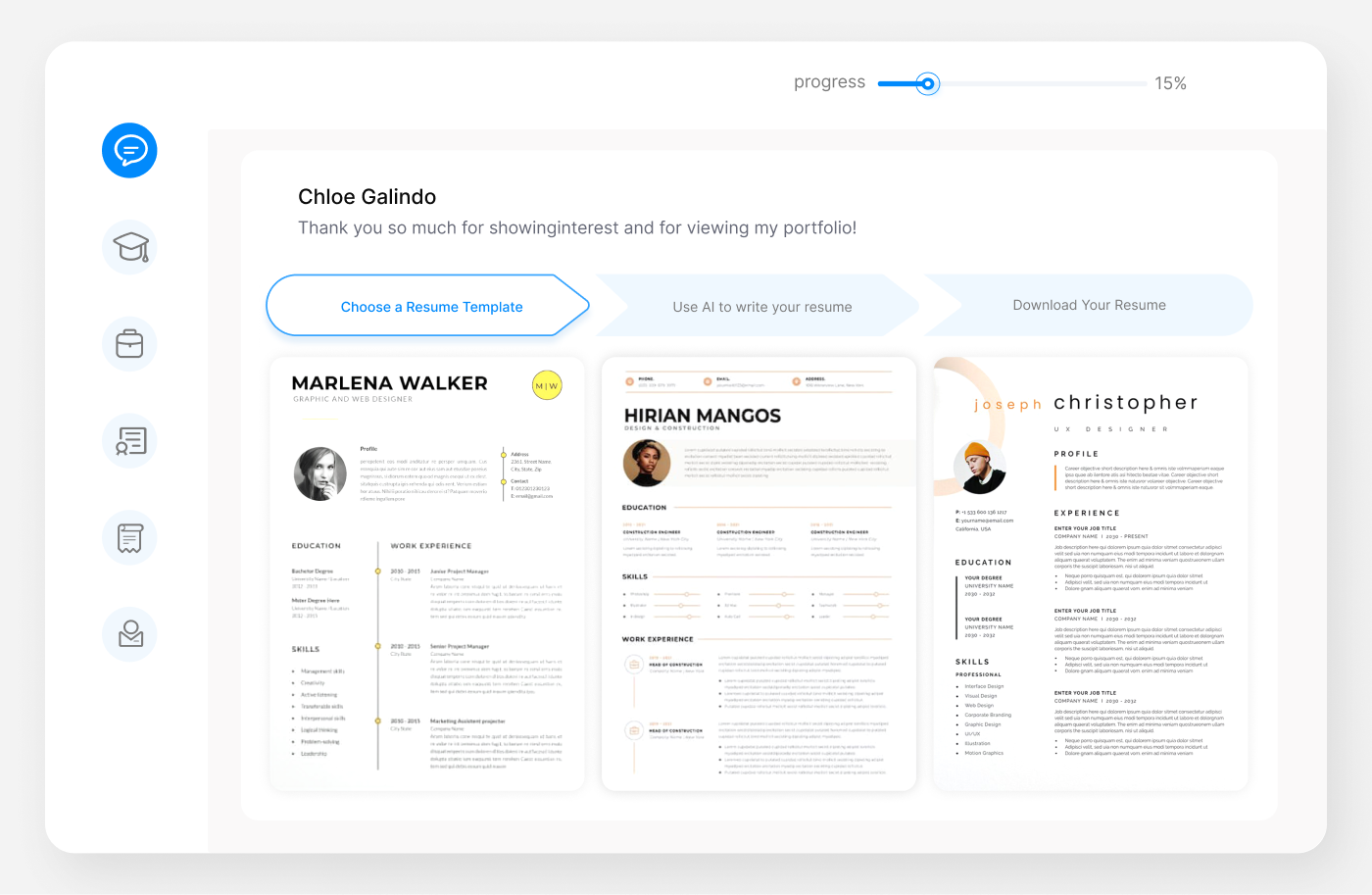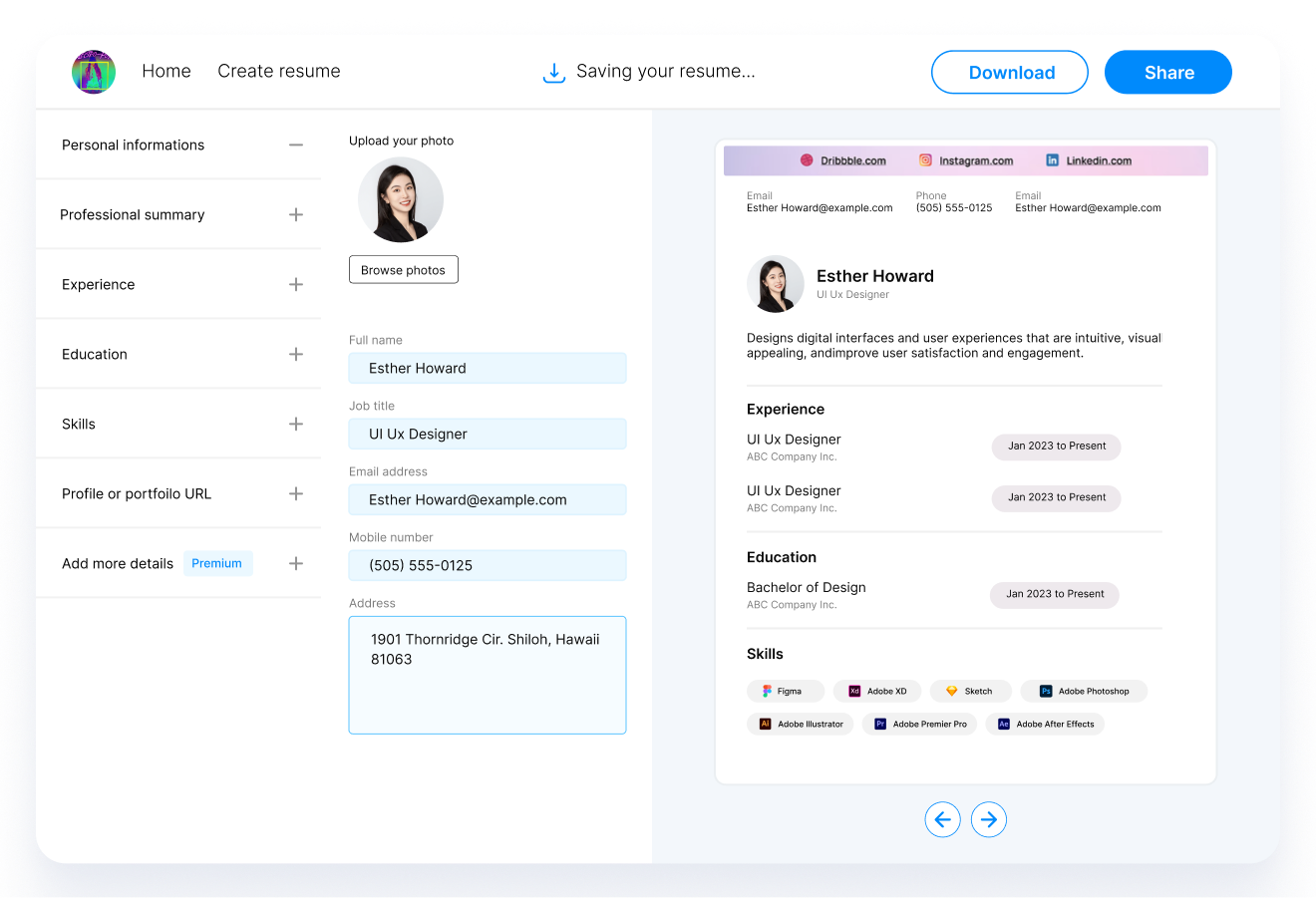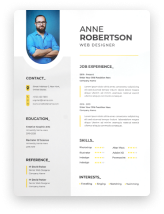In the fast-paced and vital field of emergency services, having a standout resume is crucial for any Emergency Medical Technician (EMT). This guide is designed to walk you through the intricacies of crafting a resume that not only highlights your skills and experience but also resonates with the unique demands of the EMT role. Whether you're a seasoned EMT or new to the field, our tips and examples will help you showcase your capabilities in the most effective way.

Crafting the Perfect EMT Resume: A Comprehensive Example
Johnathan Smith Emergency Medical Technician
Contact: 555-123-4567 | johnathan.smith@email.com
LinkedIn: linkedin.com/in/johnathansmithemt
Professional Summary
Dedicated and compassionate EMT with over 5 years of experience in fast-paced urban and rural emergency settings. Proven ability to remain calm under pressure, make critical decisions swiftly, and deliver exceptional patient care. Skilled in CPR, basic life support (BLS), and advanced medical protocols.
Work Experience
EMT-Basic City Health Emergency Services
New York, NY | June 2018 - Present
-
Responded to over 1,000 emergency calls, providing medical assistance and patient care in various critical situations.
-
Collaborated with a team of paramedics and nurses to ensure high-quality patient care during transport.
-
Conducted regular equipment inspections and maintenance, ensuring readiness for emergency situations.
EMT-Intern Rural Health Services
Catskill, NY | June 2016 - May 2018
-
Assisted senior EMTs and paramedics in responding to emergency calls in rural areas.
-
Gained experience in handling a variety of medical emergencies, including trauma and cardiac arrests.
-
Participated in community health programs, providing basic medical care and health education.
Education
Associate Degree in Emergency Medical Technology
Kingsborough Community College, Brooklyn, NY
Graduated 2016
Certifications
-
Certified Emergency Medical Technician (National Registry of Emergency Medical Technicians)
-
CPR and Basic Life Support (American Heart Association)
Skills
-
Emergency Medical Care
-
Patient Assessment
-
Crisis Management
-
Medical Equipment Operation
-
Communication and Teamwork
The Anatomy of an Effective EMT Resume: Structuring for Success
Crafting a well-structured resume is essential for any Emergency Medical Technician (EMT) looking to make a strong impression. The layout and organization of your resume can significantly impact its readability and effectiveness. Here's a breakdown of how to structure your resume effectively:
-
Header: Start with a clear header including your name, contact information, and any professional social media links like LinkedIn.
-
Professional Summary or Objective: This section should be a concise summary of your qualifications and career goals. For EMTs, it's crucial to emphasize skills such as quick decision-making, medical knowledge, and the ability to work under pressure.
-
Work Experience: List your relevant work experience in reverse chronological order. Highlight your responsibilities and achievements in each role, focusing on those that demonstrate your proficiency in emergency medical care.
-
Education: Include your educational background, particularly any degrees or certifications relevant to emergency medical services. For EMTs, this could include an EMT certification, CPR training, or a degree in a related field.
-
Skills: This section should outline your professional skills. For EMTs, relevant skills might include patient assessment, emergency response, CPR, and other life-saving techniques.
-
Certifications and Licenses: As an EMT, certifications are crucial. List any relevant certifications, such as your EMT license, Basic Life Support (BLS), or Advanced Cardiac Life Support (ACLS) certifications.
-
Additional Sections: Depending on your experience, you might include additional sections like volunteer work, languages spoken, or any awards or recognitions you've received.
Captivating Resume Summaries for EMT Professionals: Showcase Your Expertise
A compelling resume summary is crucial for an Emergency Medical Technician (EMT), as it provides a snapshot of your professional journey and skills. It should be a brief, impactful paragraph that captures your experience, key skills, and what you bring to the table. Here's how to craft an effective resume summary:
-
Highlight Your Experience: Begin by mentioning your years of experience in the field. For example, "Experienced EMT with over 5 years in fast-paced urban and suburban settings."
-
Emphasize Key Skills: Include skills that are crucial for an EMT, such as emergency response, patient care, and quick decision-making.
-
Mention Special Qualifications: If you have any special qualifications or certifications, such as Advanced Cardiac Life Support (ACLS) or Pediatric Advanced Life Support (PALS), mention them here.
-
Showcase Your Impact: Briefly highlight how your work has positively impacted your previous roles. For example, "Proven track record in delivering swift and accurate emergency care, resulting in numerous lives saved."
-
Tailor to the Job: Customize your summary to align with the job you're applying for. Focus on the skills and experiences that are most relevant to the position.
Here's an example of a strong EMT resume summary:
"Highly skilled and compassionate EMT with 5+ years of experience in urban emergency settings. Adept at quickly assessing patient conditions and delivering appropriate treatment. Certified in Advanced Cardiac Life Support and experienced in handling a variety of emergency situations. Known for maintaining calm under pressure and contributing to high-performing emergency response teams."
Such a summary immediately conveys your expertise, experience, and the value you can bring to a potential employer.
Detailing Your Work Experience: A Key Element for EMT Resumes
The Work Experience section is a critical part of an EMT resume. It should clearly outline your professional journey, focusing on roles and responsibilities that highlight your skills and achievements in emergency medical care. Here's how to effectively present your work experience:
-
Use Reverse Chronological Order: Start with your most recent job and work backward. This format is preferred as it highlights your current level of expertise.
-
Be Specific about Your Role: Clearly state your job title, the name of the employer, and the duration of your employment. For example, "EMT-Basic, City Health Emergency Services, New York, NY (June 2018 - Present)."
-
Detail Your Responsibilities: Describe your key responsibilities in each role. Use bullet points for clarity and conciseness. For an EMT, this might include responding to emergency calls, providing patient care, and collaborating with other emergency service personnel.
-
Highlight Achievements: Whenever possible, quantify your achievements. For instance, "Responded to over 300 emergency calls per year, providing lifesaving medical interventions and patient care."
-
Tailor to the Job: Focus on experiences and skills most relevant to the EMT role you are applying for. If the job emphasizes trauma care, highlight your experience in that area.
-
Use Action Words: Begin bullet points with action verbs like 'administered', 'coordinated', 'assisted', etc., to make your resume more dynamic and impactful.
For example:
EMT-Basic City Health Emergency Services
New York, NY | June 2018 - Present
-
Responded to an average of 300 emergency calls per year, providing immediate medical attention.
-
Conducted thorough patient assessments and administered appropriate emergency care.
-
Collaborated effectively with paramedics, police, and fire department personnel during emergency situations.
-
Maintained and restocked medical supplies and equipment in the ambulance.
Such a detailed and specific Work Experience section can significantly enhance your resume, showcasing your expertise and suitability for the EMT role.
Educational Background: Highlighting Your Foundations as an EMT
For Emergency Medical Technicians (EMTs), the Education section of your resume is not just a formality; it's a testament to your foundational knowledge and training in emergency medical care. Here's how to effectively include your educational background:
-
List Your Relevant Education: Start with your highest level of relevant education. For EMTs, this often includes an EMT certification program or an associate's degree in a related field.
-
Include the Institution and Location: Mention the name of the school, college, or institution where you received your education, along with its location.
-
State Your Degree or Certification: Clearly state the degree or certification you obtained. For instance, "Associate Degree in Emergency Medical Technology."
-
Add Graduation Date: Include the date of graduation or the date you received your certification. If you're currently enrolled, mention your expected graduation date.
-
Highlight Relevant Coursework or Achievements: If applicable, briefly mention any coursework or achievements during your education that are particularly relevant to being an EMT.
For example:
Associate Degree in Emergency Medical Technology
Kingsborough Community College, Brooklyn, NY
Graduated 2016
-
Completed rigorous coursework in emergency medical procedures, patient assessment, and crisis management.
-
Participated in extensive practical training simulations, honing skills in real-life emergency response scenarios.
By presenting your educational background clearly and concisely, you demonstrate the formal training and knowledge base that underpins your practical experience as an EMT.
Showcasing Essential EMT Skills: Tailoring Your Resume
The Skills section of your Emergency Medical Technician (EMT) resume is where you get to highlight the specific abilities that make you an effective and valuable emergency responder. Here's how to effectively showcase your skills:
-
Identify Key EMT Skills: Focus on skills that are crucial for an EMT, such as patient assessment, emergency response, medical procedure knowledge, and the ability to remain calm under pressure.
-
Be Specific: Instead of vague terms like "good communication," specify what that means in your role, such as "clear communication in high-stress situations."
-
Mix Hard and Soft Skills: Include a balance of hard (technical) skills, like CPR and emergency vehicle operation, and soft (interpersonal) skills, like empathy and teamwork.
-
Tailor to the Job Description: Align your skills with the requirements listed in the job posting. If the job emphasizes trauma care, highlight your experience and training in this area.
Example Skill Section on an EMT Resume:
-
Emergency Medical Care: Proficient in providing rapid, accurate medical assessment and treatment in emergency situations.
-
Patient Assessment: Skilled in conducting thorough patient evaluations to determine the nature and extent of injuries or illness.
-
Crisis Management: Experienced in managing high-pressure situations with calmness and efficiency.
-
Medical Equipment Operation: Well-versed in the operation of standard emergency medical equipment, including defibrillators and oxygen delivery systems.
-
Communication and Teamwork: Effective communicator, capable of coordinating with other emergency response personnel to provide optimal patient care.
By tailoring your skills to the specific demands of the EMT role, your resume will clearly demonstrate your capability and readiness for the job.
Additional Sections: Enhancing Your EMT Resume
For an Emergency Medical Technician (EMT) resume, additional sections can provide a more comprehensive picture of your qualifications and interests. These sections can set you apart from other candidates by showcasing unique aspects of your experience and personality. Here's what you can include:
-
Certifications: Apart from your EMT certification, include any other relevant certifications like Advanced Cardiac Life Support (ACLS), Pediatric Advanced Life Support (PALS), or CPR certification.
-
Volunteer Experience: If you have volunteered, especially in roles relevant to healthcare or emergency services, include this to show your commitment and experience beyond paid work.
-
Awards and Honors: Include any recognition you've received, whether for your professional skills, academic achievements, or community service.
-
Languages: Being fluent in multiple languages can be a significant asset in emergency services. Mention any additional languages you speak and your level of proficiency.
-
Professional Affiliations: Membership in professional organizations like the National Association of Emergency Medical Technicians (NAEMT) demonstrates your dedication to the field.
Example Additional Section on an EMT Resume:
Certifications
-
Advanced Cardiac Life Support (ACLS) - American Heart Association
-
Pediatric Advanced Life Support (PALS) - American Red Cross
Volunteer Experience
- Volunteer EMT, Community Health Center, Brooklyn, NY (2017-2018): Provided emergency medical services at local events and assisted in health education workshops.
Languages
- Fluent in Spanish and English
Professional Affiliations
- Member, National Association of Emergency Medical Technicians (NAEMT)
These additional sections can significantly enrich your resume, providing a fuller picture of who you are as a professional and individual.
Cover Letter Essentials for EMT Applicants
When applying for an Emergency Medical Technician (EMT) position, your cover letter is a vital component of your application. It's an opportunity to provide a more personal touch and to highlight why you are the ideal candidate for the job. Here's how to write an effective EMT cover letter:
-
Personalize Your Letter: Address the letter to a specific person if possible. Research the organization to find out the name of the hiring manager.
-
Start with a Strong Opening: Your first paragraph should grab the reader's attention. Mention your enthusiasm for the EMT role and why you're interested in this particular organization.
-
Highlight Relevant Experience: Use the body of your letter to detail your relevant experience and skills. Share specific examples that demonstrate your abilities in emergency medical situations.
-
Show Your Understanding of the Role: Discuss your understanding of the EMT position and how it fits into the broader healthcare system. This shows you're knowledgeable and serious about your career.
-
Conclude with a Call to Action: End your letter by expressing your eagerness to discuss your application in an interview. Thank the reader for considering your application.
Example EMT Cover Letter:
Dear Hiring Manager,
I am writing to express my interest in the EMT position at City Health Emergency Services. With over 5 years of experience in emergency medical care, including extensive work in both urban and rural settings, I am excited about the opportunity to contribute to your team.
In my current role at Rural Health Services, I have honed my skills in patient assessment and emergency response, often in challenging environments. My commitment to providing top-notch medical care aligns perfectly with City Health's mission to deliver outstanding emergency services.
I am particularly drawn to City Health Emergency Services because of your innovative approaches to emergency care and community involvement. I am eager to bring my skills and experience to your team and contribute to your continued success.
Thank you for considering my application. I look forward to the opportunity to discuss how I can contribute to your team.
Sincerely, Johnathan Smith
A well-crafted cover letter like this can make a strong impression and increase your chances of landing an interview.

Final Thoughts and Additional Insights for Aspiring EMTs
In wrapping up your resume guide for an Emergency Medical Technician (EMT), let's reinforce the key elements of a strong EMT resume and providing last pieces of advice.
-
Emphasize the Importance of Tailoring: Remind readers that customizing their resume for each job application is crucial. Highlighting relevant skills and experiences for the specific EMT role they are applying for can make a significant difference.
-
Encourage Proofreading and Feedback: Stress the importance of proofreading the resume to eliminate errors and seeking feedback from peers or mentors in the field.
-
Mention the Value of Continuous Learning: In the fast-evolving field of emergency medical services, staying updated with the latest protocols and certifications is key. Encourage ongoing education and professional development.
-
Discuss the Role of Networking: Mention how networking within the emergency services community can open doors to new opportunities and provide valuable support and learning resources.
-
Highlight the Reward of the Profession: Finally, remind them of the rewarding nature of the EMT role. Despite the challenges, the impact they have on saving lives and serving the community is unparalleled.
Frequently Asked Questions: Mastering the EMT Resume
In this section, let's clarify doubts and offers additional guidance to aspiring EMTs. Here are some potential questions and answers:
Q: How long should my EMT resume be?
A: Ideally, an EMT resume should be one page long, especially if you have less than 10 years of experience. Be concise and focus on the most relevant information.
Q: Should I include all my work experience on my resume?
A: Include work experience that is relevant to the EMT role. Prioritize emergency medical services experience and other roles where you've gained transferable skills.
Q: How can I make my resume stand out if I'm a new EMT?
A: Highlight your education, certifications, and any relevant training or internships. If you have volunteer experience in healthcare or emergency services, include that as well.
Q: Is it necessary to include a cover letter with my EMT resume?
A: Yes, a cover letter is important as it provides an opportunity to explain why you're interested in the role and how your skills and experiences make you a suitable candidate.
Q: Can I use the same resume for every EMT job application?
A: It's best to tailor your resume for each application. Highlight the skills and experiences that are most relevant to the specific job requirements.
Q: How important are certifications on an EMT resume?
A: Certifications are crucial in the EMT field. Ensure you clearly list all relevant certifications, including your EMT certification, CPR training, and any advanced life support qualifications.
Q: What if I don't have much experience in emergency medical services?
A: Focus on transferable skills you've gained from other experiences, such as communication, teamwork, and the ability to work under pressure. Relevant volunteer work or internships can also be valuable to include.
Q: How do I mention my language skills on my resume?
A: List any additional languages you speak under the skills or additional sections. Indicate your level of proficiency in each language.
Providing answers to these FAQs can help EMT candidates better prepare their resumes and cover letters, ultimately enhancing their chances of success in the job market.
Recommended Reading






